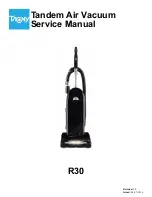
20
GB
reach head level whilst in use. Personal
injury could occur.
• Do not vacuum up substances or dusts
that are hot, glowing, combustible,
explosive or hazardous to health (dust
classes L, M, H). This includes hot
ashes, petrol, solvents, acids or caustic
solutions. Personal injury could occur.
• Caution! Do not vacuum up hazardous
substances (e.g. petrol, solvents, acids
or lyes) and ash from unauthorised fu-
els (e.g. from oil-burning ovens or heat-
ing boilers). There is a risk of injury.
• Do not vacuum up fine, combustible
dusts. There is a risk of explosion.
• Do not vacuum up hot ashes and hot,
glowing or combustible objects (e.g.
charcoal, cigarettes...). There is a risk
of fire.
• Do not vacuum up liquids, soot or plas-
ter and cement dust. You could dam-
age the equipment.
• The vacuum must not exceed a tem-
perature of 40°C. Vacuum material
that appears cool from the outside may
still be hot inside. Hot vacuum material
can re-ignite in the air stream. Further-
more, the equipment can be damaged.
In the event of a rise in temperature,
switch off the equipment and discon-
nect at the plug. Place the equipment
outside and monitor it as it cools.
The following states how damage
to the appliance and possible in-
jury to people can be avoided:
• Ensure that the equipment is assembled
correctly and the filter is in the correct
position.
• When vacuuming, do not place the
equipment on heat sensitive floors. For
safety reasons, use a fireproof base
when cleaning ovens, chimneys or bar-
becue equipment.
• Do not extinguish hot ash particles
with water, as the sudden temperature
differences can cause cracks in your
chimney.
• Use only replacement parts and acces-
sories supplied and recommended by
our service centre. The use of foreign
parts will result in immediate invalida-
tion of the guarantee.
• Have repairs carried out only by
customer service points that we have
authorised.
• Observe the instructions for the clean-
ing and maintenance of the equip-
ment.
• Empty and clean the vacuum before
and after vacuuming in order to pre-
vent the accumulation in the vacuum of
materials that represent a fire load.
• Keep the equipment in a dry place, out
of reach of children.
Assembly
Disconnect at the plug before carry-
ing out any work on the equipment.
Risk of electric shock!
1. Insert pre-filter:
Put the lip seal (15a) of the pre-
filter (15) over the edge of the
metal container (10) (see small
image).
2. Check that the pleated filter
(
13) and metal filter cage
(
14) are sitting correctly and
securely.
3. Place the container lid (5) on
the metal container (10) and
close it using the seal clips (8).
4. Connect the suction hose (11).
To do this, insert the rotatable











































